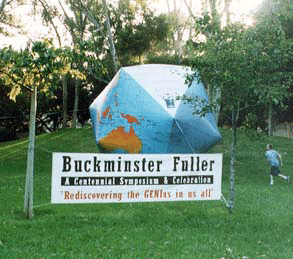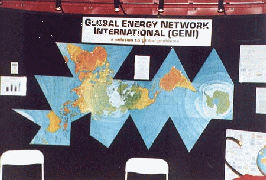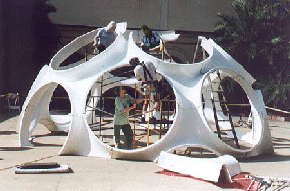|
The entire 3-day format reflected the made-for-television
culture of southern California, complete with TV-style talk show
host and musical numbers. Likewise, the conference venue,
facilities spread out all over greater San Diego, bespoke of this
culture's reliance on the automobile. We would have been helpless
to follow the giant icosahedral globe, inflated and lighted at the
various main events, without our rented Japanese minivan.
However, given the premise of using a whole city for a campus,
one had to admit that GENI had done an excellent job of matching
facilities to events. Bucky for Kids, the Dymaxion Car, and the
Design Science movies were all free and open to the public at Balboa
Park, where high tech domes, Spanish-style palisades, and a
gigantic balboa tree blended beautifully. The Saturday night
concert on Shelter Island added to the upscale milieu which made
Fuller seem fashionable, even mainstream. How could we doubt our
own reality as a cresting wave of design science sophistication,
ready to make the world work for everyone? GENI had successfully
posed the question.
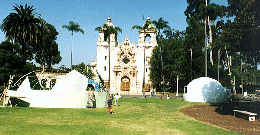
In the nine chairs on stage, from left to right, sat some of the
stars in the Fullerian constellation:
- Harold Kroto, codiscoverer of
buckminsterfullerene
- Amy Edmondson, author of A Fuller Explanation
- Walter Hickle, futuristic former governor of Alaska
- Clark Anthony, anchor for KNSD TV, our emcee for the
evening
- Peter Meisen, founder of
GENI, organizer for the conference
- Kiyoshi Kuromiya, long-time collaborator with Fuller
- Don Richter, founder of Temcor, the dome-building company
- Medard Gabel, the head of WGI
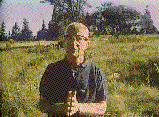
Interspersed with clips from the coming film attractions, and
Bucky impersonations by Bill Perkins, whose most convincing moment
was as a silhouetted Fuller emerging from the mists of the backlit
dome, was some fairly free-wheeling discussion. The cracks in the
conceptual superstructure were immediately obvious.
The kick-off question was about how politics doesn't seem to be
working, and Fuller's strategies to effect change outside of
politics. What did our speakers think was the problem with politics
and how effectively did Fuller demonstrate an alternative? What
followed was a lot of input from Hickle about how only global
government can protect us from the rapacity of the private sector.
Speaking as a former governor of Alaska, where much of the
resources are held by the state, he didn't see how we could protect
the ocean floors and other vast areas of the world "held in common"
if we didn't accept the need for regulatory bodies. Amidst his
remarks were lots of endorsements for US-style democracy.
Richter defended the private sector as the place where human
initiative was most effectively translated into real world
artifacts, thereby creating a government-versus-private-sector
tension as comfortably familiar as any debate on the MacNeil-Lehrer
news hour. All of this raised the hackles of certain hecklers in
the audience who were unable to contain their disappointment over
hearing Fuller repackaged in mass-market, USA Today terms. Two
individuals rose to their feet, shouting and shaking their
fists.
The emcee was doing his professional best to stick to the
script, reminding us in a reasonable tone that we had the whole
weekend to challenge the speakers with our own viewpoints, when
suddenly a gentleman in a suit and armed with a briefcase strode up
on stage, glowering at the audience, shouting how time was running
out and Bucky's critical path program had to happen NOW ("we know!"
someone shouted back), at which point he showered us with a thick
wad of purple pamphlets. His mustache looked pasted on and at first
I thought this was another impersonation of somebody, but by the
second showering of pamphlets, I realized this was another
deviation from the script -- more heartfelt intensity expressing
itself in curious ways.
Kiyoshi appeared the most amused by these disruptions and his
subsequent remarks about Fuller's subversiveness were calculated to
assure the hecklers that all hope was not lost.
Amy, who was suffering from severe sleep depravation, but not
showing it, pointed out that Fuller's faith in intuition as a
primary source of unanticipated scientific results was perfectly
illustrated in the story behind the discovery of
buckminsterfullerene, and turned it over to Kroto.
Kroto used the opportunity to effectively stump for more funding
for basic scientific research. He kept expressing wonderment that
the USA would disembowel Bell Labs, its most prestigious and
effective basic research facility, and that AT&T would then
squander the same money on advertising aimed at fighting MCI and
Sprint for long distance customers. If this was "free market
capitalism" at work, then it spelled death for basic research, and
lower living standards for all of us.
Peter Meisen also took on the question of funding, and how
humans seemed quick to rally around the flag in war time but
couldn't seem to get it together when the situation was equally
critical, but when war was not the answer. When he used the Gulf
War as an example of when the world took a stand, drew a line in
the sand, and said "no way" to Saddam, he sounded a little too
stridently Bush-like to many ears, and more shouting from the
audience ensued. Kroto picked up the ball and put the right spin on
it: we still inculcate nationalism in our children, even when we
have trouble teaching them anything worthwhile, and nationalism is
destructive. This was more what the audience needed to hear.
All of a sudden, the stage was filled with dancing girls made up to look
like teenagers, holding triangular pieces of the Dymaxion Map and carrying
on like cheerleaders to John Denver's bright little calypso tune about
the World Game. Medard looked especially uncomfortable during this interlude,
much to the amusement of his partner in the audience, Chuck Dingée.
Kroto moved his chair to watch from the wings.
The grand finale came with the introduction of Allegra Fuller
Snyder, who received a standing ovation as she walked into the
limelight. She apologized for reading a prepared speech but
explained it would be more from the heart if she didn't have to
make it up on the spot -- something she unavoidably found herself
doing later that weekend anyway, before a different audience (see
Part II of this write-up).
Allegra wanted us to share a sense of our potential to create
synergy as a network. By combining the talents and energies of all
the people in this room, with those of our colleagues and
associates unable to attend, we had what it takes to make Fuller's
dreams come true. And this is what Bucky had most hoped and longed
for, Allegra emphasized, not necessarily to be remembered, honored
and celebrated as an historical figure, as a subject of monuments
and memorials, but to be used and accessed as the impetus for a
lasting transformation in the global affairs of humanity. The way
to celebrate Fuller was to end death by starvation, solve critical
energy problems, give humanity the tools to survive and flourish
sustainably, indefinitely.
Allegra went on to recite an impressive litany of names and
their ongoing contributions to the work. Robert Gray was
mentioned, and myself, whose collaboration with Richard Hawkins illustrated the
ground-breaking potential of the internet to facilitate design
science projects, with design teams scattered geographically, but
bonded conceptually via these exciting new artifact-enabled
capabilities. This theme of the internet and design science was
echoed throughout the conference, and the Richard Hawkins
ClockTet synergetics animation made its way to Balboa Park,
where it showed between films as the cartoon.
Allegra received a glass tetrahedral sculpture to another
standing ovation, and we watched Bucky on video talking about his
lifelong dedication to omnihumanity, with echoes forward to the
closing ceremonies two nights later, at another university.
Conferees then swarmed on stage to meet the stars, and around the
Dymaxion birthday cake which had to be moved to the foyer at the
last minute because of the no food rule in the auditorium. On
stage, I met Tony deVarco for the first time, outbound managing
director of BFI, and Bonnie Goldstein, BFI's first (we hope not
last) professional archivist, also outbound with her husband Tony,
and their beautiful new baby boy, about the same age as our little girl.
I started making other contacts that evening, and continued to
do so throughout the weekend. This was, of course, a major point of
the whole symposium, to give us opportunities to rub shoulders and
swap stories and ideas -- and to pass the babies around.
Links:
Abbreviations:
- BFI : Buckminster Fuller Institute
- GENI: Global Energy Network International
- UCSD: University of California, San Diego
|
